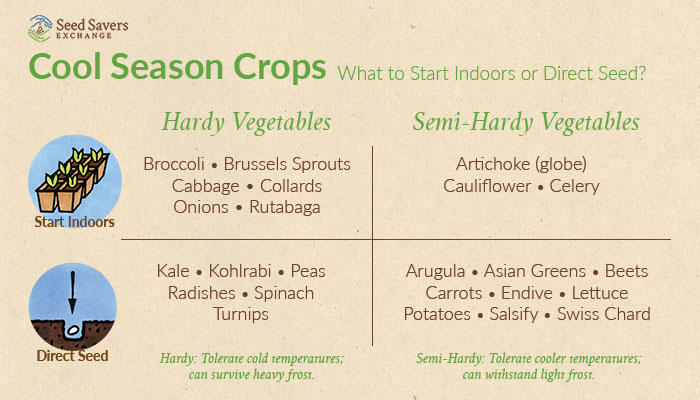COOL SEASON CROPS !!!
Grow cool season crops like lettuce, broccoli, and potatoes to get an early start on your spring garden. These crops thrive in cooler temperatures and are ideal spring plants. Knowing what to grow, when to plant the seeds, along with a few tricks, will help ensure your spring vegetables and crops thrive.
Know What to Grow
Many crops can tolerate colder weather and soil and can be planted as early spring vegetables. These plants are labeled as cool-season crops. Unlike warm-season crops, cool-season crops should be planted so that they mature when the weather is still cool and before the summer heat hits. When warm weather arrives, many of these early crops tend to “bolt” or prematurely run to seed. These crops flourish in temperatures lower than 70 degrees Fahrenheit so planting their seeds or transplants at the right time—ideally, early spring—will help ensure a healthy harvest.
Which spring garden plants you can grow (and when precisely to plant them) depends upon where you live. The USDA Plant Hardiness Zone Map—based on the average annual minimum winter temperature, divided into 10-degree Fahrenheit zones - offers expert guidance on which plants are likely to thrive in a given location.
when to start more seeds indoors for fall crops of cool-season vegetables?
If you want to grow some vegetables that like cooler weather in the fall, you need to start them indoors before it gets too cold outside. The best time to do this depends on where you live. You can use a map that shows different zones with different climates to find out your zone number. For example, if you live in zone 5, you can start planting indoors from the middle of August to September. You should plan ahead and write down when to start each vegetable. You should also be ready to plant them again if something goes wrong. This way, you can have a good harvest in the fall.
Hardy and Semi-Hardy Crops
Cool-season crops can be planted when the soil and air temperatures are at least 40 degrees Fahrenheit. These crops are often further divided into hardy and semi-hardy categories, depending upon their ability to withstand cold temperatures.
Hardy vegetables tolerate cold temperatures the best—their seeds will germinate in cool soil, and seedlings can typically survive heavy frost. Plant these seeds or transplants two to three weeks before the date of the average last spring frost; they will grow in daytime temperatures as low as 40 degrees Fahrenheit.
Semi-hardy vegetables withstand light frost. These crops grow best when the minimum daytime temperature is between 40 and 50 degrees Fahrenheit and can be sown as early as two weeks before the average last spring frost.
Some cool season crops fare better when direct seeded, while others can be started indoors. This chart outlines recommendations for popular crops:

How to Move Some Plants from Inside to Outside
You can do this with plants that like cold weather, such as broccoli, cabbage, kale, and peas. You need to use some round things called Jiffy-7s. They are made of peat and they get bigger when you add water. You can put seeds in them and they will grow. When you want to move them outside, you need to cut a small "X" on the bottom of the Jiffy-7 with a sharp tool. This will help the roots come out and grow in the soil. This is a good way to make your plants happy and healthy.
When can cool-season crops be grown for a second time in a year?
Some plants like cold weather and you can grow them again in the same year. You need to plan when to plant them based on how cold it gets and when. You can start planting them again in late summer for a fall harvest. You need to know when the first frost usually happens so you can plant the seeds inside first and then move them outside later. In USDA zone 5, you can plant them between mid-August and September. You need to get ready, plan well, and plant again if you want to grow these plants twice in a year.
Which vegetables are popular cool-season crops?
- Beet
- Broccoli
- Brussels Sprout
- Cabbage
- Cauliflower
- Chard
- Kale
- Kohlrabi
- Lettuce
- Pea
- Radish
- Spinach
- Turnip
Spring Garden Plants: Tips for Success
Gauge Soil Temperature: The odds of successfully growing cool-season crops increase if you plant them at the right temperatures so check your soil temperature before beginning. When planting seeds or transplants, measure the temperature at the recommended planting depth. Soil thermometers are available at most garden shops, but almost any thermometer will do, as long as it measures temperatures down to freezing.
Expect the Unexpected: An unexpected hard freeze can ruin young plants. Keep floating row covers or old sheets on hand to cover plants and provide necessary warmth just in case temperatures dip below cold-tolerance guidelines.
Spread Your Bets: Spring weather can be unpredictable in many regions of the country. Sow each crop in a couple batches, staggered about a week apart, to improve your odds of catching ideal growing conditions.
Double-check With the Experts: Contact your local cooperative extension office to confirm which cool-season plants thrive in your area.
FAQs About Cool Season Crops
It is essential to thin root crops like beets, radish, and turnips well after they form their second set of true leaves to ensure proper spacing for root development and avoid getting all leaves and no roots.
Root-type and leafy cool-season crops like beets, radish, turnips, lettuce, and spinach are best direct sowed into the garden, while carrots may be better off waiting for warmer weather before direct sowing.
Most cool-season veggies should be started indoors about 4 weeks prior to when you plan to plant them out, with an additional 5-6 days for hardening off to acclimate the plants to outdoor conditions.
Before planting cool-season crops, it is important to clean the garden fully and add ample amounts of aged manure or leaf compost, blending them in to prepare the soil for optimal growth and development.6. What are the ideal temperatures for cool-season crops to grow in?
Reffered by Seed Saver Exchange
Follow us on social media with hashtags #therike or #therikeinc





Leave a comment